A Revised Checklist of Amphibians and Reptiles in Camiguin Sur,Misamis Oriental,Mindaanao,Philippines
2020-04-21RussellEvanVENTURINAigoLuisDELPRADORhimAyyahKAMIRMarlonBALMORESandArvinDIESMOS
Russell Evan L.VENTURINA,Yñigo Luis C.DEL PRADO,Rhim Ayyah C.KAMIR,Marlon N.BALMORES and Arvin C.DIESMOS
1 Department of Biology,College of Science,De La Salle University,Taft Avenue,Manila
2 The Graduate School,University of Santo Tomas,España,Manila
3 Mindanao State University-Iligan Institute of Technology,Iligan City,Mindanao
4 Herpetology Section,Zoology Division,National Museum of Natural History,Philippines
Abstract The Philippines is listed as one of the world’s megadiverse countries despite its small size.Conversely,it is also on the list of global biodiversity conservation hotspots.With the threat of extinction at an alltime high,better understanding of the archipelago’s biodiversity will provide invaluable baseline information for proper conservation efforts.Here we provide an updated checklist on the herpetological biodiversity of Camiguin Sur,Misamis Oriental,Mindanao,Philippines.Field surveys and specimen collection from the municipality of Mambajao resulted in a total of 28 species (13 anurans,11 lizards,and four snakes) -all well represented by voucher specimens.Our data provides seven additional species records,updating the island’s total amphibian and reptile species count to 57,with about half Philippine-endemic.Included in the new records are three invasive alien species of amphibians:The Cane Toad Rhinella marina,the Greenhouse Frog Eleutherodactylus planirostris,and the Asiatic Painted Narrowmouth Toad Kaloula pulchra.
Keywords Camiguin Sur,amphibians and reptiles,biodiversity,Conservation
1.Introduction
The Philippines is a relatively small country compared to global regional hotspots yet is considered a powerhouse in terms of endemism and biodiversity-being second only to Madagascar(Heaneyet al.,1999;Mittermieret al.,1999;Myerset al.,2000).Over the years,the Philippines has gained the attention of biogeographers,population geneticists,conservation biologists,and phylogeneticists focusing on the country’s biodiversity and endemism as a model system relating to concepts of history and evolutionary island diversification (Heaneyet al.,2005;Brown and Diesmos,2009;Brownet al.,2013b).Conversely,the Philippines is also on the list of global biodiversity conservation hotspots (Vesilind,2002).Major international conservation organizations regard the Philippine biodiversity as one of the highest in the world for conservation concern due to threats of over-harvestation,pollution,overpopulation,and high rates of deforestation and habitat loss (Mallariet al.,2001;Onget al.,2002).
The country’s rich biodiversity is presumably explained by its complex geological history.Fluctuating sea levels during the glacial Pleistocene period caused adjacent smaller islands to repeatedly connect via land bridges,forming larger landmasses referred to as Pleistocene Aggregate Island Complexes (PAICs)now considered to be primary biodiversity regions (Brown and Diesmos,2002;Diesmoset al.,2002).The island of Camiguin Sur belongs to the Mindanao PAIC,one of the five major PAICs formed.
Much of the recent comprehensive herpetological surveys have focused on the Luzon biogeographic region with only a little documenting the southern islands-including Mindanao(Sanguilaet al.,2016).Recent studies show that the island of Mindanao supports high levels of herpetofaunal diversity and endemism (Delima,2007;Reloxet al.,2011;Diesmoset al.,2015;Plaza and Sanguila,2015;Sanguilaet al.,2016;Supsupet al.,2017).
The first assessment done on Camiguin Sur’s herpetofaunal diversity was conducted by Brown and Alcala (1967) describing only 9 species of amphibians and no reptiles.The most recent update was conducted by Sanguilaet al.in 2016 wherein a total of 50 species of amphibians and reptiles were recorded.They suggested that the herpetofauna of the volcanic island is assumed to be distinct from that of mainland Mindanao.The study of Mallariet al.,(2001) highlights the approximately 120 key biodiversity areas in the Philippines,with the island of Camiguin among the conservation priorities.
The islands of Camiguin and Mantigue in the province of Misamis Oriental have been proposed under the National Integrated Protected Areas Act of 1992 (NIPAS Act),the basis for the establishment and management of protected areas in the country (Mallariet al.,2001),as two of the Philippines’biodiversity conservation priority areas,having a priority level of extremely high and critical (Onget al.,2002).In Camiguin Sur,Mounts Timpoong (1630 m a.s.l.) and Hibok-hibok (1332 m a.s.l.) serves as primary water sources for island residents and are regarded as a suitable habitat for native flora and faunal biodiversity.
Mt.Timpoong is characterized by a mixture of secondary forests from 500-700 m a.s.l.and old growth forests and mossy forest at 700-1200 m a.s.l.An ultramafic enriched soil with rich vegetation further characterizes the area housing different species of ferns,floral shrubs,emergent perennials,and is dominated by dipterocarps at the canopy layer of secondary and old-growth forest.In terms of biodiversity,it is home to endemic species of birds,mammals,and frogs:the famousColasisi,the Camiguin Hanging ParrotLoriculus camiguinensis;the Camiguin Forest MouseApomys camiguinensis;the Camiguin Hawk-OwlNinox leventisi;and the Camiguin Cross FrogOreophryne nana(Baleteet al.,2006;Brown and Alcala,1967;Heaney and Tabaranza,1997,2006a,b;Heaneyet al.,2006;Telloet al.,2006;Rasmussenet al.,2012).
The need for site revisiting and reassessment fills in gaps of knowledge on the full extent of the country’s biodiversity(Delimaet al.,2007).Recent descriptions of newly discovered species,new distribution records,and the growing number of undescribed,potentially new species warrants further studies to provide better estimates of the archipelago’s biodiversity(Sanguilaet al.,2016).Furthermore,effective species-specific conservation planning and intervention (Supsupet al.,2017) can only be done with the necessary baseline information such as species records and profiling.
In this paper,we report species accounts and additional findings of our own data from a joint survey of the Philippine National Museum of Natural History (PNMNH) and the Department of Environment and Natural Resources (DENR)on amphibian and reptile biodiversity in the island of Camiguin Sur,Mindanao.The new data gathered provide baseline information in reviewing the conservation status and the biogeographic range of included species,the extent of invasive alien species,and the conservation of the island’s biodiversity.
2.Materials and Methods
2.1.Study AreaCamiguin Sur is a steeply mountainous,actively volcanic island located 10 km of the north coast of Misamis Oriental,Mindanao (Figure 1).The island has an area of approximately 265 km2divided into five municipalities which includes Mambajao,Catarman,Sagay,Mahinog,and Guinsiliban (Heaney and Tabaranza,1997,2006a;Figure 2).Geographically,towards the center of the island,four mountains can be found:Mt.Timpoong,Mt.Hibok-Hibok,Mt.Tres Marias,and Mt.Mambajao.Together with the PNMNH and DENR,field work was conducted on four sites in Camiguin Sur Island,Municipality of Mambajao,specifically the three sites on Mount Timpoong:the nursery area -Sitio Campana,the base camp at Sitio Pamahawan,and a midmontane forest between 900-1200 m a.s.l..The fourth site was conducted within the vicinity of DENR-Mambajao compound(summarized in Table 1).Herpetofaunal inventories were done for potential new records of amphibians and reptiles in the island province.Gratuitous permits were obtained from the local government (DENR-Mambajao,Camiguin).Field collection survey was done during the rainy season from 24 February to 1 March 2017.

Figure 1 Map of the Philippines,showing the recognized Pleistoscence Aggregate Island Complexes (PAICs) modified from Diesmos et al.,2014.

Figure 2 Map of Camiguin Sur showing the five municipalities found in the island,and the sampling site located in the municipality of Mambajao,indicated by the star during our field work(sampling period:February 27-March 4,2017;coordinates:09.19119° N,124.70837° E).
Brief description of our sampling sites are as follows:1)Nursery area,Sitio Campana,Barangay Pandan,Municipality of Mambajao (elevation:650 m a.s.l.,coordinates:09.2047° N,124.7102° E).A small residential area at the base of Mount Timpoong with a large area dedicated for agricultural livelihood.Chainsaw activities (eg.coco-lumber),road-building,and forest rehabilitation projects (eg.plant nursery) were also observed.
2) Sitio Pamahawan,Barangay Pandan,Municipality of Mambajao (elevation:738 m a.s.l.,coordinates:09.19273° N,E124.70837° E).The general habitat for the area is a mixed artificial forest (GmelinaarboreaRoxb.andlarge-leafed mahoganySwietenia macrophyllaKing) transitioning to a secondary lower montane forest dominated by dipterocarps.Decaying tree stumps,logs,and slabs were observed.Sampling was done from an elevation of 738 m a.s.l.to about 900 m a.s.l.3) Montane to old-growth forest (1200 m a.s.l.,coordinates:09.18139° N,124.71648° E).Survey was conducted along existing trails by steep hillsides,slopes,and ridges at altitudes between 900-1200 m a.s.l.,and established monitoring plots by the DENR Mambajao.Sampling area was characterized as a mossy forest dominated by ferns,rattan palms,and dipterocarps.Emergent trees were also present and dominated the mid-montane forest.Several decaying stumps and logs were also observed.
4) DENR compound,Municipality of Mambajao (elevation:32 m a.s.l.,coordinates:09.24537° N,124.72618° E).Sampling site was in the built-up area around the vicinity of the municipal office and the office of the DENR.Heavy rain falls resulted in temporary mud-ponds around the offices.Nearby houses and buildings,and agricultural areas also surrounded the area.
2.2.Sampling TechniqueField techniques included a combination of timed searches,microhabitat sampling,and tape recording of advertisement calls of male frogs (Heyeret al.,1994).Opportunistic sampling technique was carried out since no transect could be established due to inclement weather conditions that lasted throughout the sampling dates of our fieldwork.Sampling collection was done at 14:00-16:00 and 18:00-24:00,working in small groups of three to six persons.Habitats and microhabitats such as tree holes,burrows,rotten logs,tree buttresses,tree foliage,leaf litter,and isolated pools were targeted (Figure 3).Adult specimens were hand-caught,while tadpoles were collected through dip netting.Specimens were photographed live on white background,and following standard preservation protocol (Heyeret al.,1994;Simmons,2002) were fixed using a 10% buffered formalin solution and preserved in 70% ethanol.Liver samples were extracted from all specimen and persevered in absolute ethanol-filled cryogenic tubes.Specimens collected were authenticated by the curator of the Philippine National Museum of Natural History-Dr.Arvin C.Diesmos.All voucher specimens were tagged and deposited in the PNMNH.Taxonomic identification for accepted and correct scientific names were checked and verified using up to date guidelines of existing Philippine herpetofaunal checklist for amphibians and reptiles (Diesmoset al.,2008,2014,2015;Levitonet al.,2018;Taylor,1922,1923;Uetzet al.,2016) including the International Union for the Conservation of Nature(IUCN) status and endemicity of each species listed in this study.Each of the recorded species’ conservation status were based on the updated 2019 IUCN Red List of Threatened Species and were indicated for each figure corresponding to the individual recorded during the survey.Several herpetofaunal checklistsconducted throughout the archipelago were also consulted for taxonomic purposes and distribution guidelines (seeBrownet al.,2000,2012,2013a;Delima,2007;Devan-Song and Brown,2012;Diesmoset al.,2005;McLeodet al.,2011;Oliveroset al.,2011;Plaza and Sanguila,2015;Reloxet al.,2011;Sanguilaet al.,2016;Sileret al.,2011,2012;and Supsupet al.,2016,2017).Morphometric measurements (Snout Vent LengthSVL,Tail LengthTL,Total Length,and weight) were obtained for each specimen collected.

Table 1 Survey sites in Camiguin Sur,Mindanao with corresponding elevation and habitat type.
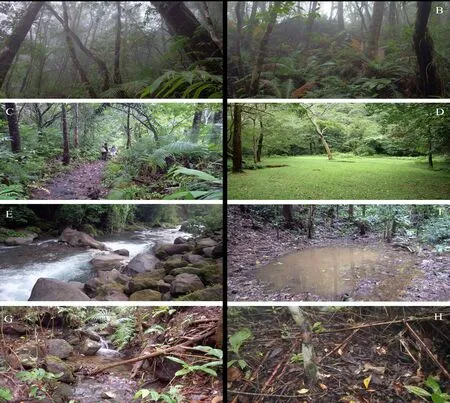
Figure 3 Examples of habitats sampled and asessed in Mt.Timpoong,Camiguin Sur.A and B:Old growth forest at 900-1200 m a.s.l.dominated by mosses,ferns,and emergent trees.C and D:Scondary growth forest at 500-700 m a.s.l.dominated by dipterocarps and trees planted by the local government.E:Tuasan River.F:A temporary pond after rainfall.G and H:Stream and leaf litter microhabitats.
3.Results
The herpetofaunal survey conducted resulted to a total of 28 amphibian and reptile species including 13 species of frogs,11 species of lizards,and four species of snakes.Seven of the 28 species are new records to the island of Camiguin Sur:three invasive alien anuran species,three species of native lizards,and one native species of snake.These additional records increase the total herpetological diversity count recorded for the island of Camiguin Sur to 57 species,47% of which are endemic to the Philippines.New records include two Philippine endemic species of lizards (Lepidodactylus herreiandLamprolepis smaragdina philippinica),a widespread non-endemic house gecko(Hemidactylus platyurus) and an endemic species of ratsnake(Gonyosoma oxycephalum).Conversely,three invasive alien frog species (Rhinella marina,Eleutherodactylus planirostris,andKaloula pulchra) were found to be well established in the town of Mambajao of Camiguin Sur.The spread of these frogs poses a huge threat to populations of endemic species (Diesmoset al.,2006).An updated checklist on the herpetofauna of the island of Camiguin Sur,Misamis Oriental,Philippines is provided in Table 2.Accounts for each species recorded in this study were also included with notes on their natural history and distribution.
Species Account
AMPHIBIA
Anurans
Bufonidae
Rhinella marina (Linneaus 1758)
Cane Toad
Remarks:Introduced.The species was found abundant in agricultural plantations and built-up areas in the town of Mambajao.Adult male specimens were observed calling in temporary ponds in front of the DENR Camiguin Office.This is the first record ofRhinella marina(Figure 4) in the island province of Camiguin Sur.The Cane Toad was introduced in 1934 to control pest populations of sugarcane crops and has successfully established breeding populations throughout the country (Meriño,1934;Diesmoset al.,2006).R.marinaare widely distributed in the country and are commonly found near rice paddies,plantations,and near human settlements.Specimens were not collected.
Distribution:Alabat,Bohol,Calayan,Catanduanes,Cebu,Cocomo,Dinagat,Gigantes Norte,Leyte,Lubang,Luzon,Marinduque,Masbate,Mindanao,Mindoro,Negros,Palawan,Panay,Polillo,Romblon Island Group,Sicogon,Samar,Ticao,Verde (Diesmoset al.,2015).
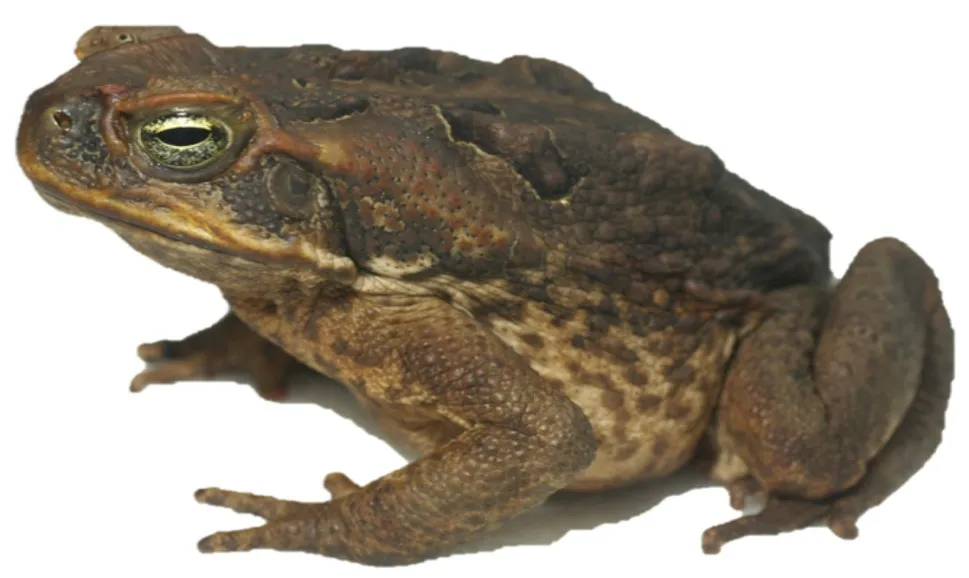
Figure 4 Rhinella marina (Linneaus,1758).IUCN Status:Least Concern (LC).Photo by Arvin C.Diesmos.
Ceratobatrachidae
Platymantis corrugatus (Dumeríl,1853)
Masked Wrinkled Brown Frog
Remarks:Endemic.Eight specimens ofP.corrugatus(Figure 5) were collected from Mt.Timpoong (700-1000 m a.s.l.).Specimens were found on leaf litter on the forest floor,with adult males being easier to find as they made their advertisement calls.Males are smaller (SVL:30.3-36.8 mm;Weight:3.1-3.8 g) as compared to females (SVL:43-48 mm;Weight:7.1-9.0 g).
Distribution:Widely distributed in the Luzon PAIC,Bohol,Cagaray,Camiguin Sir,Catanduanes,Cebu,Dinagat,Leyte,Mindanao,Negros,Panay,Polillo,Samar,Siquijor (Diesmoset al.,2015).
Specimens:PNM 10036,10047,10057,10058,10077,10078,10081,10082.

Figure 5 Platymantis corrugatus (Dumeril,1853).IUCN Status:Least Concern (LC).Photo by Arvin C.Diesmos.
Dicroglossidae
Fejervarya vittigera (Weigmann,1834)
Philippine Grass Frog
Remarks:Endemic.Only one juvenileF.vittigera(Figure 6)was collected (SVL:29.9 mm;Weight:2.1 g) near temporary ponds in front of the office of DENR Camiguin where mating calls of adult males were heard during the heavy down-pour of rain.Locals were observed with bag-fulls of the species for consumption,hunting them in pools and canals around the town.This species can be found in wetlands and nonforest areas up to 600 m a.s.l.(Diesmoset al.,2014) and have a habitat overlap between invasive anuran species in the country(Diesmoset al.,2006).
Distribution:Found in Bohol,Cagraray,Caluya,Camiguin Sur,Cocomo,Dinagat,Guimaras,Leyte,Lubang,Luzon,Marinduque,Masbate,Mindanao,Mindoro,Negros,Palawan,Pan de Azucar,Panay,Polillo,Romblon Island Group (Diesmoset al.,2015).
Specimen:PNM 10095.

Table 2 Amphibians (Anurans) and Reptiles (Lizards and Snakes) of Camiguin Sur,Misamis Oriental,Mindanao,Philippines.Published reports on species are marked by ✓ are shown in columns,including our data during the field survey indicated with numbers (1-4) instead,based on their sampling location.(Legend:* endemic species;+invasive anurans;★ new records).

Figure 6 Fejervarya vittigera (Wiegmann,1834).IUCN Status:Least Concern (LC).Photo by Arvin C.Diesmos.
Limnonectes leytensis (Boettger,1893)
Philippine Swamp Frog
Remarks:Endemic.Limnonectes leytensis(Figure 7) were seen in the secondary forests of Mt.Timpoong in sites 1 and 2.Specimens were seen in temporary pools left by rains during the sampling period.Mating calls were also heard within the area.No specimens were collected.
Distribution:Basilan,Bohol,Camiguin Sur,Cebu,Dinagat,Leyte,Mindanao,Negros,Romblon Island Group,Sulu Archipelago (Diesmoset al.,2015).
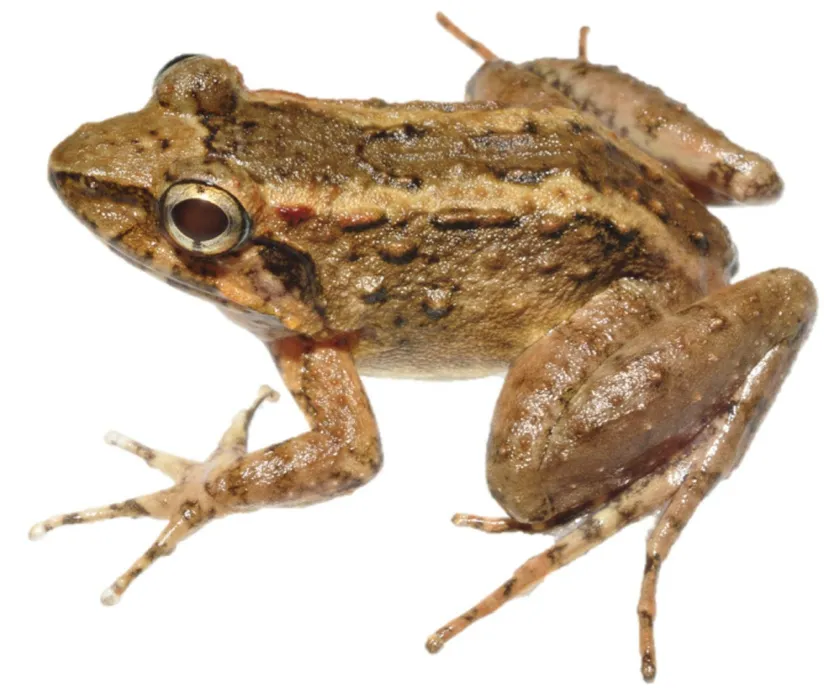
Figure 7 Limnonectes leytensis (Boettger,1893).IUCN Status:Least Concern (LC).Photo by Arvin C.Diesmos.
Limnonectes magnus (Stejneger,1910)
Philippine Fanged Frog
Remarks:Endemic.Limnonectes magnus(Figure 8) were documented from streams in secondary growth forests in site 2 and in temporary ponds and agricultural areas in site 1.LikeF.vittigera,locals were observed hunting this frog species for consumption.Local consumption with the addition of continuous habitat fragmentation raises the conservation status of this endemic to near threatened (Diesmoset al.,2006).
Distribution:Basilan,Biliran,Camiguin Sur,Dinagat,Leyte,Mindanao,Samar (Diesmoset al.,2015).
Specimens:PNM 10045 and 10096.

Figure 8 Limnonectes magnus (Stejneger,1910).IUCN Status:Near Threatened (NT).Photo by Arvin C.Diesmos.
Eleutherodactylidae
Eleutherodactylus planirostris (Cope,1862)
Greenhouse Frog
Remarks:Introduced.A good number ofE.planirostris(Figure 9) were found inside the compound of DENR Camiguin.Males were heard calling behind buildings and open storage areas,hidden among potted plants,confiscated wood planks,and stored equipment.The invasive Greenhouse Frog was first recorded in Mindanao by Olsonet al.in 2014 and has never been recorded in the island of Camiguin Sur.Despite the rapid expansion of distribution records of this small invasive frog,it was still surprising to find that it has now reached the island.

Figure 9 Eleutherodactylus planirostris (Cope,1862).IUCN Status:Least Concern (LC).Photo by Arvin C.Diesmos.
Distribution:Native:Cuba,Bahamas,Cayman Islands;Philippines:Luzon,Mindanao (Olsonet al.,2014;Syet al.,2015).
Specimens:PNM 10089,10090,10091,10092,10093,10098.
Microhylidae
Kalophrynus sinensis (Peters,1867)
Rufous-sided Sticky Frog
Remarks:Endemic.Two maleK.sinensiswere collected at around 1200 m a.s.l.near the transects set by DENR Mambajao on Mt.Timpoong.Two color morphs were observed:blunt green and brown coloration.Both were found on a dried-up streambed surrounded by large stones and boulders (Figure 10).Distribution:Basilan,Bohol,Camiguin Sur,Culion,Dinagat,Leyte,Mindanao,Samar (Diesmoset al.,2015).
Specimens:PNM 10079 and 10080.

Figure 10 Kalophrynus sinensis (Peters.1867).IUCN Status:Least Concern (LC).Photo by Arvin C.Diesmos.
Kaloula conjuncta (Peters,1863)
Mindanao Narrow-mouth Toad
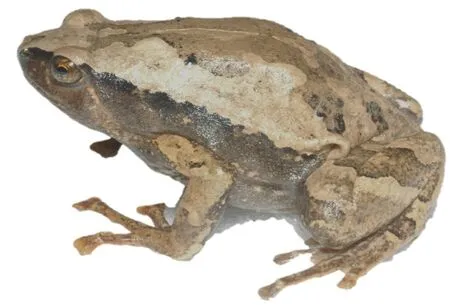
Figure 11 Kaloula conjuncta (Peters,1863).IUCN Status:Data Deficient (DD).Photo by Arvin C.Diesmos.
Remarks:Endemic.Kaloula conjuncta(Figure 11) currently previously has three subspecies with allopatric distributions(K.c.conjuncta,K.c.negroensis,andK.c.merdionalis).However,phylogenetic studies (Blackburnet al.,2013) suggest a reassessment of its taxonomy where Sanguilaet al.(2016)highlights the importance of independent assessments of its conservation status.Currently accepted as one species by the most recent account by Diesmoset al.,2015.Only 1 adult male specimen was found and collected at site 2.
Distribution:Alabat,Borocay,Caluya,Catanduanes,Cebu,Guimaras,Leyte,Luzon,Mindanao,Mndoro,Negros,Pacijan,Panay,Polillo,Poro,Romblon Island Group,Semi-rara,Siquijor,Sulu (Diesmoset al.,2015).
Specimen:PNM 10056.
Kaloula pulchra Gray,1831
Asiatic Painted Narrow-mouth Toad
Remarks:Introduced.Kaloula pulchra(Figure 12) were found within and around the compound of DENR Camiguin.Adult males were observed floating in temporary ponds,calling for females right after rainfall.Members of the species are often found in ponds and canals near human settlements and disturbed areas,and are more commonly encountered during the rainy season.This species is easily recognized by locals due to their distinct and loud mating call.The invasiveK.pulchrawas introduced to the country possibly thru pet trade with the first specimen recorded in Laguna in 2003 (Diesmoset al.,2006).Accidental introduction to agricultural and horticultural products supports the rapid spread and increase in the population ofK.pulchrain the Philippines (Diesmos and Brown,2011;Syet al.,2014).This is the first record ofK.pulchrain the island of Camiguin Sur.
Distribution:Cebu,Luzon,Mindoro,Palawan (Diesmoset al.,2015).
Specimen:PNM 10094.
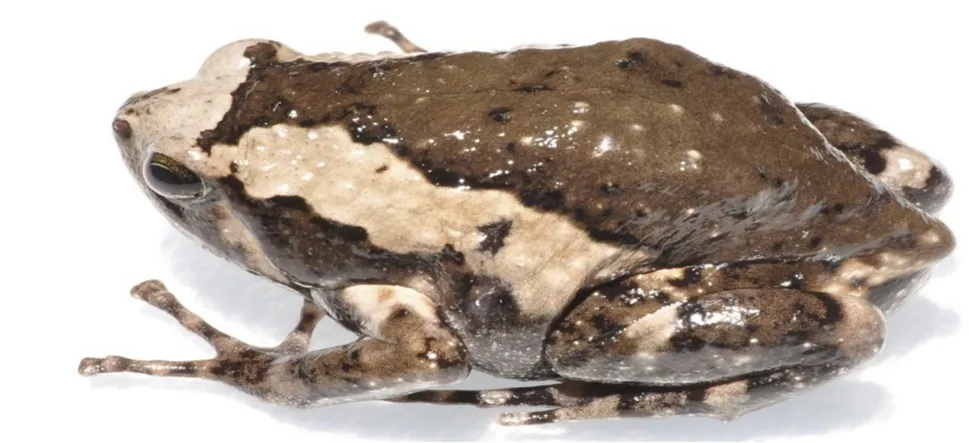
Figure 12 Kaloula pulchra Gray,1831.IUCN Status:Least Concern (LC).Photo by Arvin C.Diesmos.
Oreophryne nana Brown and Alcala,1967
Camiguin Cross Frog
Remarks:Endemic.Oreophryne nana(Figure 13 was previously thought to be a microendemic frog species known only from the island of Camiguin Sur.However,Sanguilaet al.(2016)currently suggests referring to allOreophrynespecimens found in north-east Mindanao as“O.cf.nana”prior to further molecular and morphological studies.First documented in the Philippines by Brown and Alcala 1967,only female specimens were used to describe the new species.In our study,nine adult males were captured and are now deposited in PNMNH,the first collection of male specimens in Camiguin Sur.Males are smaller (SVL 14.0-16.8 mm) as compared to females (eight females with SVL 17-20 mm;seeBrown and Alcala,1967).Males were found perched on leaves calling for females in all sites on Mt.Timpoong.Advertisment calls were recorded.
Distribution:Camiguin Sur Island,north-east Mindanao(Sanguilaet al.,2016).
Specimens:PNM 10037,10063,10064,10065,10066,10067,10086,10087,10088.

Figure 13 Oreophryne nana Brown and Alcala,1967.IUCN Status:Data Deficient (DD).Photo by Arvin C.Diesmos.
Ranidae
Pulchrana grandocula (Taylor,1920)
Mindanao Striped Stream Frog
Remarks:Endemic.Two specimens ofP.grandocula(Figure 14) were collected by a flowing stream in a secondary growth forest at approximately 700 m a.s.l.Populations of this species are widely distributed in the Mindanao PAIC (Sanguilaet al.,2016).
Distribution:Basilan,Biliran,Bohol,Camiguin Sur,Dinagat Leyte,Mindanao,and Samar (Diesmoset al.,2015).
Specimens:PNM 10038 and 10042.
Rhacophoridae
Polypedates leucomystax (Gravenhorst,1829)
Asiatic Tree Frog

Figure 14 Pulchrana grandocula (Taylor,1920).IUCN Status:Least Concern (LC).Photo by Arvin C.Diesmos.
Remarks:Native,non-endemic.Polypedates leucomystax(Figure 15)is widely distributed throughout the Philippines and neighboring countries.The species is commonly encountered near rivers,ponds,and streams,with established populations even in disturbed and agricultural areas.Only tadpole specimens were obtained from a pond in site 2.
Distribution:Batan,Bohol,Cagayan,Cagaray,Calagna-an,Camiguin Norte,Camiguin Sur,Catanduanes,Cebu,Dinagat,Fuga,Gigantes Norte,Gigantes Sur,Guimaras,Inampulugan,Jolo,Leyte,Lubang,Luzon,Mactan,Marinduque,Masbate,Mindanao,Mindoro,Negros,Pacijan,Palaui,Palawan,Pan de Azucar,Panay,Polillo,Romblon Island Group,Samar,Semirara,Sicogan,Verde (Diesmoset al.,2015).

Figure 15 Polypedates leucomystax (Gravenhorst,1829).IUCN Status:Least Concern (LC).Photo by Arvin C.Diesmos.
Rhacophorus pardalis Günther,1858
Emerald Flying Frog
Remarks:Native,non-endemic.Rhacophorus pardalis(Figure 16)were observed attached to leaves of trees about 5-10 m from the ground.Two specimens were found on leaves of a tree directly over a temporary pool of water.During the surveys,we caught two specimens in amplexus,heard male advertisement calls,and found eggs in one of our specimen bags,highlighting the breeding season of the species.
Distribution:Basilan,Bohol,Camiguin Sur,Catanduanes Dinagat,Leyte,Luzon,Mindanao,Negros,Romblon Island Group,Samar,Siquijor (Diesmoset al.,2015).
Specimens:PNM 10043,10044,10046,10083,10084,10085.

Figure 16 Rhacophorus pardalis Günther,1858.IUCN Status:Least Concern (LC).Photo by Arvin C.Diesmos.
REPTILIA
SAURIA (Lizard)
Agamidae
Bronchocela cf.cristatella (Kuhl,1820)
Green Crested Lizard
Remarks:Endemic.Brochocelacf.cristatella(Figure 17) specimens were found sleeping on branches of trees and shrubs in secondary growth forests with one around 10 m directly over a stream.Widely referred to as“hunyango,”locals mistake it as a type of Chameleon as it has the ability to change from a bright green coloration to a dark brown when captured.Sanguilaet al.(2016) suspects taxonomic problems within the genus regarding populations found on the Mindanao PAIC and those from the Luzon PAIC and other Sunda landmasses.For taxonomic remarks onB.cf.cristatellla,see Brownet al.(2012),Mcleodet al.(2011) and Supsupet al.(2016).
Distribution:Palawan,Calamian Islands,Panay,Luzon,Mindanao,Sulu,Cebu,Bohol,Leyte,Negros,Samar,Mindoro,Masbate,and Agusan del Norte.
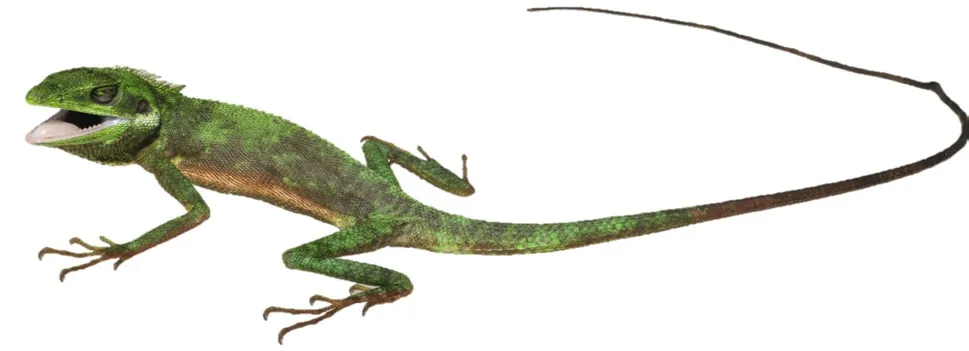
Figure 17 Bronchocela cf. cristatella (Kuhl,1820).IUCN Status:Least Concern (LC).Photo by Arvin C.Diesmos.
Specimens:PNM 10041 and 10068.
Gonocephalus sp.
Philippine Forest Dragon
Remarks:Taxonomy forGonocephalusspecies (Figure 18) is uncertain mainly due to the lack of scientific studies for this genus and the absence of specific type localities in the original species descriptions (Brownet al.,2000;Sanguilaet al.,2016).The phylogentic analysis conducted by Weltonet al.(2016)with the three Philippine species ofGonocephalus(G.semperii,G.sophiae,andG.interruptus) was unable to fully resolve the taxonomic issue of the genus where they suggest use of more robust datasets and analyses.This species was found abundant throughout Mt.Timpoong,seen asleep on the trunks of small,slender trees around 1-3 m from the ground.
Distribution:Luzon,Cebu,Panay-Negros,Mindanao,Pollilo,Mindoro,Bohol,Samar,Leyte (Weltonet al.,2016).
Specimens:PNM 10050-10055,10059-10062,and 10069.

Figure 18 Gonocephalus sp.IUCN Status:Data Deficien (DD).Photo by Arvin C.Diesmos.
Gekkonidae
Cyrtodactylus annulatus (Taylor,1915)
Annulated Bow-fingered Gecko
Remarks:Endemic.Cyrtodactylus annulatus(Figure 19) were found active at night on tree trunks in secondary forests in sites 1 and 2.We collected three adult males and one gravid female.
Distribution:Mindanao,Sulu Archipelago,Bohol,Cebu,Pacijan,Siquior,Inampulugan.
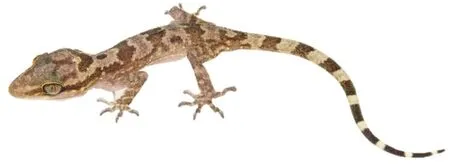
Figure 19 Cyrtodactylus annulatus (Taylor,1915). IUCN Status:Least Concern (LC).Photo by Arvin C.Diesmos.
Specimens:PNM 10039,10049,10070,10071.
Lepidodactylus herrei (Taylor 1923)
Negros Scaly-toed Gecko
Remarks:Endemic.This is the first record ofL.herrei(Figure 20) in Camiguin Sur.Only a single gravid specimen was observed.It was found on a tree clinging to a leaf around 5 m high at around 800 m a.s.l.
Distribution:Negros,Lazuarriaga,and Cebu,Camiguin Sur Specimen:PNM 10072.

Figure 20 Lepidodactylus herrei (Taylor 1923). IUCN Status:Least Concern (LC).Photo by Arvin C.Diesmos.
Gekko gecko (Linnaeus,1758)
Tokay Gecko
Remarks:Native,non-endemic.Gekko gecko(Figure 21)are found throughout the archipelago.The species is well recognized in the country due to its large size,abundance near and in human settlements,and its distinct call earning it the local name“tuko.”Members of the species are common in built up areas and tree plantations.
Distribution:Widely distributed in Asia.

Figure 21 Gekko gecko (Linnaeus,1758). IUCN Status:Least Concern (LC).Photo by Arvin C.Diesmos.
Hemidactylus frenatus Duméril and Bibron,1836
Common House Gecko
Remarks:Native,non-endemic.Hemidactylus frenatus(Figure 22) are widely distributed in Asia.The species coexists with humans in built-up areas.
Distribution:Widely distributed in Asia.
Specimen:PNM 10701.

Figure 22 Hemidactylus frenatus Duméril and Bibron,1836. IUCN Status:Least Concern (LC).Photo by Arvin C.Diesmos.
Hemidactylus platyurus (Schneider 1797)
Asian House Gecko
Remarks:Endemic.H.platyurus(Figure 23) is another common house lizard species in the Philippines.Despite being a widespread species,this is the first record ofH.platyurusin the island of Camiguin Sur.The species was observed inside homes and establishments near site 4 but were not collected.
Distribution:Southeast Asia,Australia,Papua New Guinea.

Figure 23 Hemidactylus platyurus (Schneider 1797). IUCN Status:Least Concern (LC).Photo by Arvin C.Diesmos.
Scincidae
Brachymeles orientalis (Brown and Rabor,1967)
Southern Burrowing Skink
Remarks:Endemic.An adult femaleB.orientalis(Figure 24) was collected during day time under a decaying log near site 2.The species is tolerant of disturbance and is common in the soil of residential areas and coconut plantations (Sanguilaet al.,2016).
Distribution:Bohol,Mindanao,Samar,Leyte,Dinagat,Camiguin Sur islands.
Specimen:PNM 10073.

Figure 24 Brachymeles orientalis (Brown and Rabor,1967). IUCN Status:Least Concern (LC).Photo by Arvin C.Diesmos.
Eutropis multicarinata multicarinata (Gray,1845)
Philippine Mabuya
Remarks:Native,non-endemic.Eutropis multicarinata(Figure 25) is a commonskink species found in disturbed areas to secondary growth forests.A single specimen was observed moving along leaf litter near site 2 during day time.Sanguilaet al.(2016) highlight the probability of cryptic speciation among the populations of the species.
Distribution:Malaysia (Borneo),Philippines (incl.Bohol,Mindanao),Indonesia (Talaud archipelago),Palau (Belau)islands,Taiwan (Lanyu) China,Micronesia.
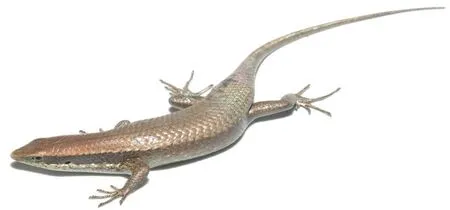
Figure 25 Eutropis multicarinata multicarinata (Gray,1845). IUCN Status:Least Concern (LC).Photo by Arvin C.Diesmos.
Lamprolepis smaragdina philippinica (Mertens,1829)
Green Tree Skink
Remarks:Endemic.Specimens ofLamprolepis smaragdina philippinica(Figure 26) were found in day time perched on a coconut tree near the area of DENR Camiguin.This species is frequently encountered in coastal areas and coconut plantations throughout the country.Although known to exist in the Mindanao PAIC,this is the first record of this species in Camiguin Sur.
Distribution:Southeast Asia.

Figure 26 Lamprolepis smaragdina philippinica (Mertens,1829).IUCN Status:Least Concern (LC).Photo by Arvin C.Diesmos.
SERPENTES (SNAKES)
Colubridae
Gonyosoma oxycephalum (Reinwardt in F.Boie,1827)
Red-Tailed Green Ratsnake
Remarks:Endemic.A singleGonyosoma oxycephalum(Figure 27) was sighted dead on the road leading up to site 1.The fastarboreal snake species is widespread in the Philippines but is rarely encountered.This is the first report ofO.oxycephalumoccurring in Camiguin Sur.Specimen was in a state of decomposition and was no longer collected.
Distribution:Babuyan Ids.(Calayan,Camiguin Norte),Balabac,Batan,Bohol,Dinagat,Leyte,Lubang,Luzon (Prov.:Aurora,Ilocos Norte,Isabela,Laguna,Nueva Vizcaya,Quezon,Sorsogon,Zambales),Marinduque,Mindanao (Prov.:Agusan del Sur,Davao Oriental,South Cotabato,Surigao del Sur,Zamboanga City),Negros,Palawan,Panay (Prov.:Aklan,Antique,Iloilo),Sabtang,Sibuyan,Sulu Archipelago (Bongao)(Levitonet al.,2018).

Figure 27 Gonyosoma oxycephalum (Boie,1827).IUCN Status:Least Concern (LC).Photo by Arvin C.Diesmos.
Lamprophiidae
Oxyrhabdium modestum (Duméril,Bibron and Duméril,1854a)
Philippine Shrub Snake
Remarks:Endemic.Individuals ofOxyrhabdium modestum(Figure 28) were encountered at night perched on branches and vegetation,on tree stumps,and on the forest floor.This species is endemic the the Mindanao PAIC.
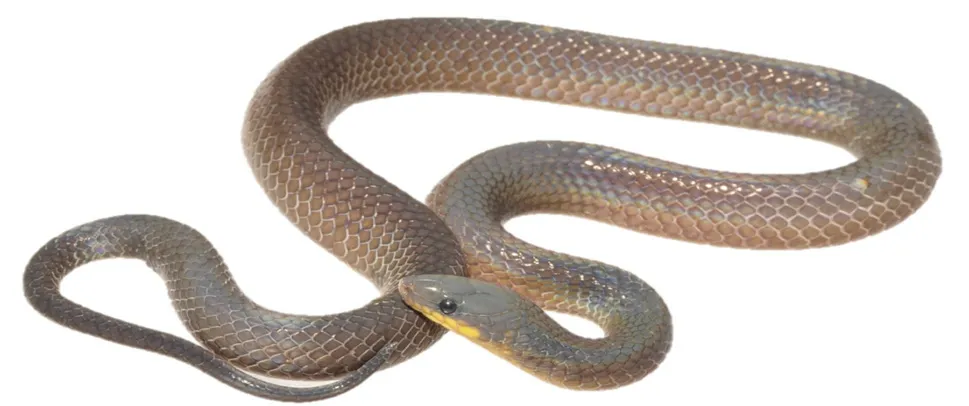
Figure 28 Oxyrhabdium modestum (Duméril,Bibron,and Duméril 1854a).IUCN Status:Least Concern (LC).Photo by Arvin C.Diesmos.
Distribution:Basilan,Biliran,Bohol,Camiguin Sur,Catanduanes,Dinagat,Leyte,Maripipi,Mindanao (Prov.:Agusan del Norte,Agusan del Sur,Bukidnon,Cotabato,Davao,Davao Oriental,Davao del Sur,Misamis Occidental,Misamis Oriental,South Cotabato,Sarangani,Zamboanga del Norte,Zamboanga del Sur [Zamboanga City]),Samar (Levitonet al.,2018).
Specimens:PNM 10040,10048,10074,10075.
Psammodynastes pulverulentus (H.Boie in F.Boie,1827)
Philippine Mock Viper
Remarks:Native,non-endemic.A single specimen of the widely distributedP.pulverulentus(Figrure 29) was encountered at night perched on a small tree.The species is found all throughout South East Asia and is considered of least concern.
Distribution:Balabac,Basilan,Batan Ids.(Batan,Sabtang),Bohol,Calamian Archipelago (Busuanga),Camiguin Sur,Cebu,Dinagat,Leyte,Luzon (Prov.:Albay,Aurora,Cagayan,Camarines Norte,Camarines Sur,Ilocos Norte,Isabela,Laguna,Nueva Vizcaya,Quezon,Sorsogon),Mindanao (Prov.:Agusan del Norte,Agusan del Sur,Bukidnon,Davao,Lanao del Sur,Misamis Occidental,Misamis Oriental,South Cotabato,Surigao del Norte,Zamboanga del Norte,Zamboanga del Sur [Zamboanga City]),Negros (Prov.:Negros Occidental,Negros Oriental),Palawan,Panay,Polillo,Samar,Siargao,Sulu Archipelago (Bongao,Jolo) (Levitonet al.,2018).
Specimen:PNM 10076.

Figure 29 Psammodynastes pulverulentus (H.Boie in F.Boie,1827)IUCN Status:Least Concern (LC).Photo by Arvin C.Diesmos.
4.Discussion
The earliest checklist on the herpetological biodiversity of Camiguin Sur was from a survey and collection done by Brown and Alcala in 1967.They recorded nine species of frogs from Mt.Hibok-Hibok.It is through this collection that they first described the Camiguin Cross FrogOreophryne nanabased on all female voucher specimens.Our collection of male specimens will prove useful in future taxonomic and phylogenetic studies for the species between populations of Camiguin Sur and of northeast Mindanao (seeSanguilaet al.,2016).
A more recent and more robust biodiversity checklist for the island was provided by Sanguilaet al.(2016).They targeted the entire northeast Mindanao in their surveys and included adjacent islands such as Camiguin Sur.A total of 126 species of reptiles and amphibians were documented with 50 species represented in Camiguin Sur (Table 2).Of the 50 they documented,we were able to record only 21 of the same species possibly due to continuous rains during the span of our surveys.However,this may also be the reason we documented 7 species records new to the island of Camiguin Sur,bringing the total herpetological biodiversity count of Camigiun Sur to 57 species.
Invasive alien species (IAS) are known as non-native species that have the ability to establish and dominate in a new area,spreading quickly while outcompeting other species,often ending in extinction (Clavero and Garica-Berthou,2005;Clout and Williams,2009).Currently,there are six invasive amphibian species known to be established in the country:the American Bullfrog (Lithobates catesbeianus[Shaw,1802]),the Asiatic Painted Toad (Kaloula pulchraGray,1831),the Cane Toad(Rhinella marina),the Chinese Bullfrog (Hoplobatrachus rugulosus[Wiegmann,1834]),the Green Paddy Frog (Hylarana erythraea[Schlegel,1837]),and the Greenhouse Frog (Eleutherodactylus planirostris) (Diesmoset al.2006;Olsonet al.2014).Of the six,three have now invaded the small island of Camiguin Sur.However,there is still a large gap of knowledge on the impacts of these invasive alien frogs on the ecology of native biodiversity despite growing global attention on the implications of these problematic species to conservation (Alcala and Brown 1998;Brown and Diesmos,2002;Brownet al.2012a;Diesmoset al.2014).
Species on the list (Table 2) but not included in the species accounts are the following:VaranuscumingiMartin,1839 andNajasamarensisPeters,1861.Records were based from interviews with a personnel from the local DENR office and from photos of aV.cumingirescued from hunters.Species that may possibly occur in the island but were not included due to uncertainty are the following:Philautussp.andCuora amboinensis(Daudin,1801).Advertisement calls of aPhilautusspecies were heard during the survey in site 1.The possible occurrence of the Southeast Asian Box Turtle (Cuora amboinensis) was based from interviews from DENR stating that the species can be found around the Ardent hot springs of Mambajao.It is necessary to include them as supplemental information for future studies in Camiguin Sur.
Emerging threats to the island’s endemism and biodiversity
The island of Camiguin,despite its small size,is a species rich island that contributes to the Mindanao PAIC’s biodiversity with 51% island endemicity for amphibians and reptiles.Most of the invasive alien species (IAS) of amphibians observed on this Northern Mindanao island,Rhinella marina,Eleutherodactylus planirostrisandKaloula pulchra,are new records of anurans that are potential threats to the native wildlife (Diesmoset al.,2006).Native species that directly overlap in terms of habitat with the IAS are the endemic lowland anuransFejervarya vittigera,Limnonectes magnusandPulchrana grandocula.Moreover,bothF.vittigeraandL.magnusare being hunted for local consumption.Additionally,the possibility of these IASpenetrating forests will have a tremendous effect on Philippine amphibian conservation as over 80% are forest obligates (Brownet al.,2001).
Much of the forest remains of Camiguin were removed by commercial logging in the 1980s followed by clearing for agricultural purposes (Heaney and Tabaranza,2006).Reforestation efforts in Mt.Timpoong resulted in the introduction of non-native Mahogany,observed in both the nursery area (Site 1) and Sitio Pamahawan (Site 2).
Another factor threatening local ecosytem is the growing population of locals in Camiguin.During the 1980s,there were only 57 000 inhabitants in the area,which was projected to double by the year 2020 (Heaney and Tabaranza,2006).The growing population of Camiguin directly affects resource use within the area.Majority of the population rely on the resources given freely by the mountains of Camiguin,and unsustainable use of these resources will greatly affect not only the people,but also the island’s biodiversity.In response to these environmental threats,the local government together with the DENR have moved steadily in recent years to have the upland areas where forest remains declared theTimpoong-Hibok-hibok Natural Monument(Heaney and Tabaranza,2006a).Recently,Mount Timpoong Hibok-Hibok National Monument has been declared a protected ASEAN Heritage Park in the Philippines by the ASEAN Centre for Biodiversity (ACB).
The data collected on the surveys are limited to the selected localities on Mount Timpoong and in the municipality of Mambajao and is insufficient to provide a quantitative analysis on abundance and species richness,herpetofaunal diversity index,or analysis of spatial and elevational variation as no transects,nor quadrats were performed.For future conservation and management efforts,more herpetofaunal surveys and biodiversity studies are highly recommended.
AcknowledgementsWe would like to thank the following for making this field expedition possible and successful:the Philippine National Museum of Natural History(PNMNH),the local government of Camiguin Sur,Mindanao and the Department of Environment and Natural Resources-Mambajao for the logistics support and permit to collect,allowing us to conduct herpetofaunal assessment in Mount Timpoong Hibok-hibok National Monument (MTHHNM) and other areas within the island.We would also like to extend our gratitude to the our colleagues who assisted us,for support and company:Dave General,Rolly Urriza,Cecilia Banag-Moran,Sarah Grace Zamudio,and the local guide Jhoner Abian for his extensive effort and support during our field survey.
杂志排行
Asian Herpetological Research的其它文章
- Changes on Anuran Tadpole Functional Diversity along an Environmental Gradient at the Southernmost Atlantic Rainforest Remnant
- Does Light Exposure during Embryonic Development Affect Cognitive Behavior in a Lizard?
- Species Diversity and Elevational Distribution of Amphibians in the Xianxialing and Wuyishan Mountain Ranges,Southeastern China
- Genetic Differentiation of the Forest Crested Lizards,Calotes emma alticristatus Schmidt,1925 and C.emma emma Gray,1845 (Squamata:Agamidae) Relating to Climate Zones in Thailand
- A New Species of the Asia n Toad Genus Megophrys sensu lato(Anura:Megophryidae) from Guizhou Province,China
